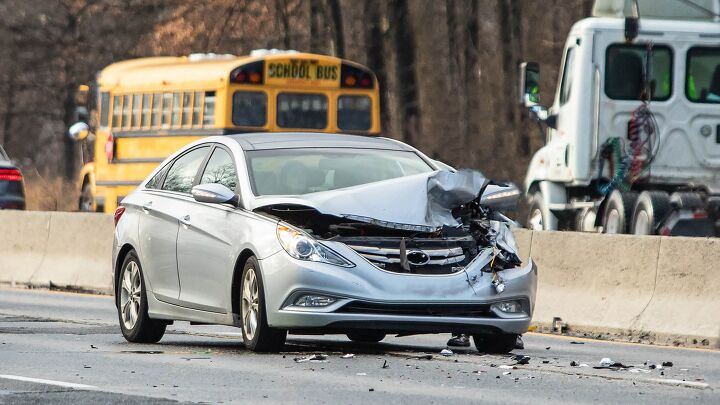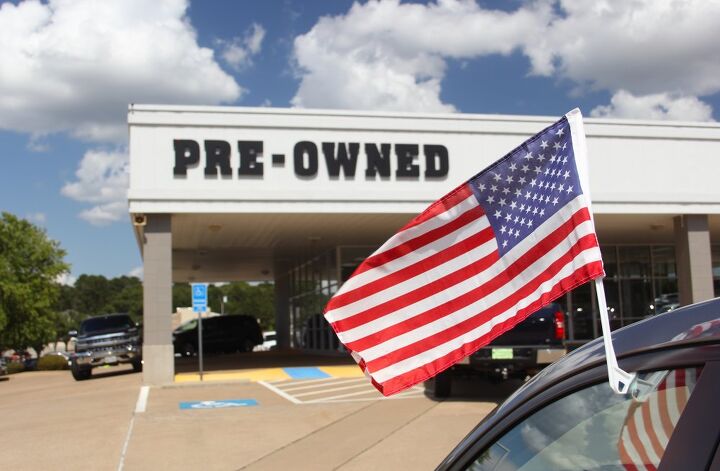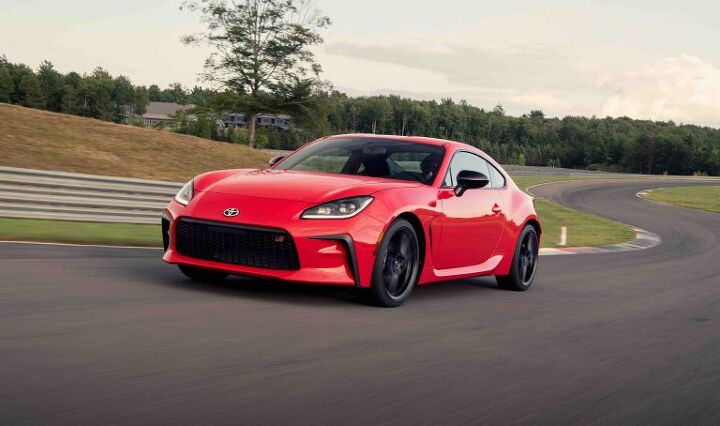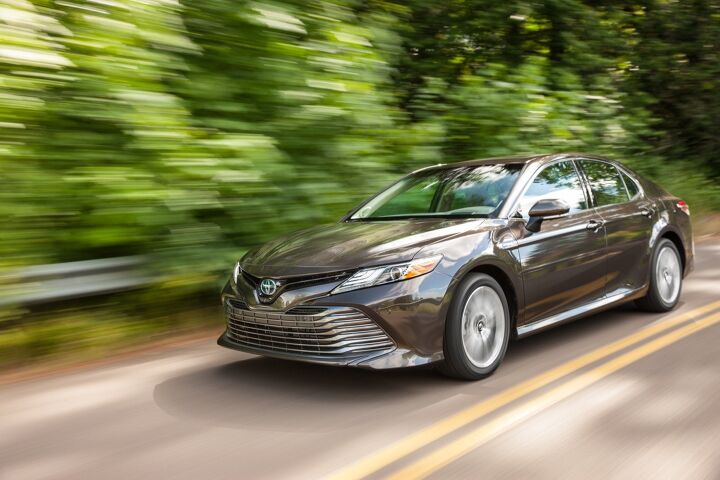#CarPrices
Car Insurance Rate Increases Offset the Gradual Price Drops
New car prices are slowly returning to reality, but the universe isn’t done torturing buyers. A new report from Reuters found that insurance rates are climbing just as the financial pain of buying a new car is easing.
Insane Survey Claims Most People Would Pay $19,000 Over MSRP
With vehicle prices surging over the last two years, the age of negotiating a price below sticker seems to have ended. Manufacturers are raising their rates to cope with inflation. But they’ve also noticed how much abuse they’ve been willing to endure via dealer markups. You rarely hear someone talking about how much they saved on their new car anymore. Now, the topic of interest is how much financial abuse you managed to avoid before driving it off the lot.
Study: The Fifteen Most Overpriced Vehicles of 2022
With automotive prices skyrocketing these last two years, you may have found yourself waiting out the market until wealthy business magnates, unaccountable banking institutions, and multinational monopolies have had their way with it – hoping beyond hope that they’ll be a modestly priced car for you to live in when the economic dust finally settles.
But what if you can’t wait that long and need something today? While may not be able to steer you toward the deal of a lifetime, we do know which vehicles you might want to cross off your list thanks to a study targeting mainstream models seeing the highest dealer markups. Though, be warned, you’re still probably better off driving whatever you have today because the national average still has vehicles listed 10 percent above MSRP.
Report: Wholesale Used Car Prices Are Coming Down, Don't Get Too Excited
If you’ve started hoarding auto parts in the event that future car prices fail to stabilize, leaving you indefinitely maintaining whatever heap is currently in your garage, there’s some good news incoming. Used vehicle prices have begun to fall, even if they’ve not yet reached the kind of valuations we might actually consider reasonable.
Tesla Raises Prices Twice This Week
Tesla is receiving a lot of attention for having increased prices twice in one week. The Model 3, often presented as the company’s most-affordable option catering to the masses, now starts at $48,440 in the United States. Its crossover equivalent, the Model Y, now starts at a whopping $64,400 while larger products have surpassed the six-figure point of entry. Despite being the brand’s oldest model, the Model S saw increases over the summer (when it was just $90,000) and has since settled into $101,200 before you’ve even said the words Plaid or Full Self Driving. But the Model X remains even more expensive at $116,200.
Worse yet, those who can afford such vehicles won’t even be able to get them in a timely fashion. Despite weathering COVID restrictions rather well vs legacy automakers, supply chain issues seem to have caught up with the EV manufacturer. Wait times on order vehicles are now several months long. Some customers are being told that they’ll likely have to wait until 2023, specifically those hoping to score a Model X.
Toyota Proudly Announces 2022 GR86 Will Be Slightly Cheaper Than Subaru BRZ
Toyota has announced pricing for the 2022 GR86, with the Hachiroku receiving an MSRP of $27,700 before destination. That’s $295 cheaper than the nearly identical Subaru BRZ. Though, when you’re effectively building a sports coupe that has a literal clone of itself on sale across the street, every tiny advantage suddenly becomes relevant.
While a couple of hundred bucks aren’t likely to sway someone holding any amount of brand loyalty, it could become the deciding factor for interested parties who see the Toyobaru Twins as otherwise identical. The problem is that they actually do have distinctive personalities, despite still being overwhelmingly similar at their core, and the price difference shrinks even more once you accounted for each manufacturer’s delivery fees.
AutoNation Wildly Profitable While Car Prices Are Grotesquely High
With automobile prices ballooning to egregiously high levels, one might assume that the industry would be in rough shape. But they’d be dead wrong. Supply chain disruptions have actually created a captive market where consumers are desperate to lay their hands on whatever products are available. In the automotive realm, this has allowed retailers to set ludicrous prices and rake in larger profits per transaction. While inflation may eventually catch up to these entities, the gravy train is currently parked at the station and dousing big business with its warm, brown effluence.
Nobody knows this better than the folks at AutoNation. Because the company just released a quarterly profit report that blew its rosiest projections out of the water. Net income its ongoing operations was $361.7 million for Q3 2021, double the $182.6 million witnessed in Q3 of 2020, while revenue rose 18 percent to $6.4 billion.
It's Not Just Pricing, Auto Loans Are Also Getting Out of Hand
As you’re undoubtedly aware, now isn’t the best time to purchase a new vehicle. While you can currently sell your ride for more than it’s realistically worth, the economy is anything but stable as inflation and supply shortages gum up the works. A lack of semiconductor chips has caused the automotive industry to stutter endlessly throughout 2021, with the issue getting so bad that some manufacturers have been building unfinished vehicles just to give their employees something to do. Ford is even mulling over a strategy to ship those units directly to dealerships so they’ll have something on the lot — effectively making its retail network responsible for final assembly.
But the logistics nightmare is only part of the story. Automotive loans are also becoming untenable as terms stretch out endlessly. Cars continue getting more expensive and the average consumer is losing their buying power. The preferred solution is for financiers to extend agreements so customers can continue making the same monthly payments while accruing more on interest over the duration. While effective in the short term, and bound to make banks money as we’re all driven deeper into debt, one wonders how this plays out on a grander scale.
How Long Are Vehicle Prices Going To Remain Insane?
With just about every resource trading at unappealing premiums, now may not be the time to make any major purchases unless you’re a financial masochist or so wealthy that the normal rules of living no longer apply. But it remains a seller’s market for just about everyone, including the plebian masses. Giant, unaccountable financial institutions will happily purchase your home and there’s a sea of disenfranchised people who will give you their last dollar if you can help them make sense of an increasingly hectic world. In the automotive sphere, we’ve seen dealerships and rental agencies hungrily scooping up secondhand automobiles for unheard-of prices just so they’ll have something on the lot.
The end result is a lot of overpriced merchandise that larger businesses are desperate to buy so they can pass on their elevated expenses to the customer. We’ve already covered the stupidly high prices surveyed consumers claimed they’d be willing to spend on a new vehicle. But there have been numerous reports claiming those days are coming to an end, with just as many suggesting we’re still in the thick of it. Yours truly has been wondering just how close to reality those assertions happen to be.
The Great Used Car Buyup of 2021
With automakers having a difficult time keeping production schedules thanks to COVID restrictions nuking demand and upending supply chains, 2021 arrived with plenty of problems. Desperate to replenish fleets they had sold off while everyone was locked indoors, rental agencies went on a used car buying spree. But it wasn’t just rental fleets that needed to be restocked, dealerships are also finding themselves with fewer models on the lot than they’re accustomed to — which is a bad position to be in when surveys have revealed consumers are now willing to pay stupidly high prices for automobiles.
They’re reportedly going to great lengths to acquire used cars as the great buyup of 2021 continues.
Chinese Auto Market Continues Its Decline; U.S. Future Also Looking Bleak
China’s auto sales declined for the ninth consecutive month in March, further proving that the market isn’t as infallible as once thought. The assumption was that, as North America surpassed peak growth and flattened out, Chinese auto sales would continue an upward trajectory. But, while China did surpass the U.S. in becoming the world’s largest auto market, it’s not living up to its billing as a golden goose.
That’s not to suggest the U.S. is about to stand triumphantly atop that mountain. Automakers are issuing profit warnings for 2019 and Moody’s Investors Service expects light vehicle sales to fall 1.2 percent this year.
“The accommodative financing environment that had helped buoy U.S. car sales is receding. Maintaining operating and financial discipline will be crucial [for 2019],” the bond credit rating business advised.
Attention, Plebs: New Cars Are Becoming Prohibitively Expensive
As new vehicle prices continue to climb, many wonder how high MSRPs can go before the public decides to take a pass — assuming they haven’t already. Sales growth is slowing, even in seemingly bulletproof markets like China. Even before this ominous backdrop unfurled, dealers were making noise about new car prices that had grown overly ambitious, claiming they couldn’t endure another period of sustained economic hardship.
Edmunds estimates that the average transaction price of a new vehicles reached $36,495 in December 2018 — a 3 percent increase compared to December of 2016 and a 13 percent increase compared to December of 2012. Taking that knowledge, Road & Track compiled a broader picture of the new-car market and where it might be going.
Spoilers ahead if you don’t want the unpleasant non-surprise ruined.
Ailing Motorcycle Industry Could Be Canary in Coal Mine for Automakers - Part Two
Last week, we discussed how the motorcycle industry’s total failure to entice new riders for over a decade has come back to bite it in the ass. Two-wheeled ownership declined drastically in the United States after the Great Recession and never really bounced back. Blame a disinterested population of youngsters with less discretionary funds and few entry-level options to consider.
I speculated that automakers could be on a similar path, despite the passenger car segment being more of a necessity for average commuters and less apt to collapse outright. But that isn’t to presume they might not be subject to similar pitfalls, and we’ve a new one to consider. Harley-Davidson, which serves as the poster child for the motorcycle industry’s current crisis, recently announced it will end all U.S. production of motorcycles sold in Europe.
Those bikes will now be manufactured overseas. The company said in a regulatory filing with the U.S. Securities and Exchange Commission that retaliatory tariffs levied by the European Union on motorcycles exported from the U.S. jumped from 6 percent to 31 percent. Harley-Davidson’s already expensive products come at an additional premium in Europe, and the the company estimates the new fines will add another $2,200 per motorcycle, on average.
Ailing Motorcycle Industry Could Be Canary in Coal Mine for Automakers
If you think car enthusiasts are a dying breed, you should take a look at motorcyclists. The two-wheeled industry is in serious trouble. A total failure in marketing occurred over the past decade. New riders aren’t coming in fast enough to replace the glut of Baby Boomers rapidly aging out of the market, and there’s a looming paranoia that self-driving vehicles could push bikes off the road entirely.
In 2017, U.S. motorcycle sales were down 11 percent, and no company was hit harder than Harley-Davidson. The brand has the oldest consumer base and has repeatedly failed at recruiting younger riders. While it builds a fine product, it’s not one that appeals to millennials. This generational cohort proved hesitant to engage in motorcycling as a pastime — a situation not helped by having less disposable income than Generation X or the Boomers did at the same stage in their lives. Young women are also poised to start out-earning young men, and few brands have successfully tapped into the female demographic.
2018 Toyota Camry Prices and Fuel Economy Ratings - More Money, More Power, More MPGs
The 2018 Toyota Camry will be priced from $24,380, including delivery, when it goes on sale this summer — a $425 increase compared with the base 2017 Camry.
Riding on an evolution of the Prius and C-HR’s Toyota New Global Architecture, the 2018 Camry is an all-new design for the first time since the 2012 model year. Market positioning is key, even for a Camry that’s been America’s best-selling car for 15 consecutive years, as demand for midsize sedans is quickly falling and even Toyota is seeing greater interest in the RAV4 than the historically dominant Camry. With new competitors approaching from Honda and Nissan, Toyota isn’t fooling around with this hugely important launch.
All eighth-generation Camrys are equipped with an eight-speed automatic. There’s essentially no tangible weight increase. The Camry offers the most standard horsepower in the midsize segment, the optional 3.5-liter V6 now produces 301 horsepower, and all Camrys now include Toyota Safety Sense P with pedestrian detection, radar cruise control, lane departure alert with steering assist, and auto high beams.
Perhaps most notably, highway fuel economy jumps all the way to 41 miles per gallon; above 50 mpg for Camry Hybrids.




























Recent Comments